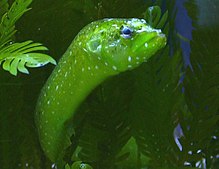Congrogadinae
| Congrogadinae | |
|---|---|

| |
| Congrogadus subducens | |
| Scientific classification | |
| Domain: | Eukaryota |
| Kingdom: | Animalia |
| Phylum: | Chordata |
| Class: | Actinopterygii |
| Clade: | Percomorpha |
| (unranked): | Ovalentaria |
| Family: | Pseudochromidae |
| Subfamily: | Congrogadinae Günther, 1862[1] |
Congrogadinae is a
Pseudochromidae
, these elongated fish are commonly called eel-blennies.
Characteristics
The species in the subfamily Congrogadidae have elongated rather eel-like bodies which are covered in with small
caudal fin is joined to the long dorsal and anal fins in a small number of species but is separated in all the others. They have a protractable mouth and there is a rear facing spine on the opercle. They have between one and three complete or partial lateral lines. There are no teeth on the palatine and they may or may not be present on the vomerine bone. They grow to a maximum length of 40 centimetres (16 in).[2]
They lay eggs which are covered in hooks, some of which may develop into filaments. The eggs are clumped together in an egg mass the hooks on the eggs' surfaces interlocking with each other, which is most likely guarded by the male.[3]
Distribution and habitat
The species in the Congrogadinae inhabit
Gondwanaland broke up and dispersed into the western Pacific Ocean.[4]
Genera
The following genera are included within the Congrogadinae:[1][2]
- Günther, 1872
- Günther, 1862
- Günther, 1872
- J.L.B. Smith, 1952
- Halimuraenoides Maugé & Bardach, 1985
- Haliophis Rüppell, 1829
- Natalichthys Winterbottom, 1980
- Rusichthys Winterbottom, 1979
References
- ^ a b Bailly N, ed. (2017). "Congrogadinae Günther, 1862". FishBase. World Register of Marine Species. Retrieved 14 October 2018.
- ^ ISBN 978-1-118-34233-6. Archived from the originalon 2019-04-08. Retrieved 2018-10-14.
- doi:10.1139/z90-133.
- ^ "Description of the book Revision and Vicariance Biogeography of the Subfamily Congrogadinae (Pisces: Perciformes: Pseudochromidae) by Richard Winterbottom". NHBS. Retrieved 14 October 2018.
